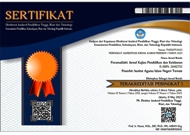Pelayanan Pelanggan Melalui Balanced Scorecard untuk Mencapai Tujuan Pendidikan
Abstract
Keywords
Full Text:
PDFReferences
Averson, Paul (2004), Building a Government Balanced Scorecard: Phase 2 – Implementation and Automation.http:www.balanced scorecard.org.Gasperz, Vincent, (1997), Management Kualitas. Jakarta: PT Gramedia Pustaka Utama.
Gaspersz, Vincent (2003), Sistem Manajemen Terintegrasi: Balanced Scorecard dengan Six Sigma untuk Organisasi Bisnis dan Pemerintah, Jakarta, Gramedia. Hoyle, D. (2007). Quality Management Essentials. Oxford: Elsevier Limited. Imelda R. H. N https://media.neliti.com/media/publications/74766-ID-implementasi- balanced-scorecard-pada-org.pdf Kaplan, Robert S dan David P. Norton.(1997). Balanced Scorecard: Menerapkan Strategi Menjadi Aksi. Jakarta.Erlangga Menteri Pendayagunaan aparatur Negara RI, (2003), Keputusan Menteri Pendayagunaan Aparatur Negara No. 63/KEP/M.PAN/7/2003. Mulyadi.(2007). Balanced Scorecard. Jakarta. Salemba Empat. Mustaqim.(2012). Sekolah/Madrasah Berkualitas dan Berkarakter.Jurnal Nadwa, Vol6(1) Pusat Bahasa Departemen Pendidikan Nasional (2008).Kamus Bahas Indonesia.Jakarta Ririn Tri Ratnasari dan Mastuti Aksa, Teori dan Kasus Manajemen Pemasaran Jasa Sallis, E. (2002) Total Quality Management in Education. London: Kogan Page Ltd. Sutarto HP. (2015).Manajemen Mutu Terpadu (MMT-TQM) Teori dan Penerapan Di Lembaga Pendidikan, Jogjakarta.Uny Press Tjiptono, F., dan Diana, A. (2003). Total Quality Management. Yogyakarta: Penerbit Andi.
DOI: http://dx.doi.org/10.46339/foramadiahi.v14i1.791
Refbacks
- There are currently no refbacks.
Copyright (c) 1969 Rohman Rohman, Neneng Komariah, Oo Sodikin, Iim Wasliman, Supyan Sauri

This work is licensed under a Creative Commons Attribution-NonCommercial-ShareAlike 4.0 International License.


